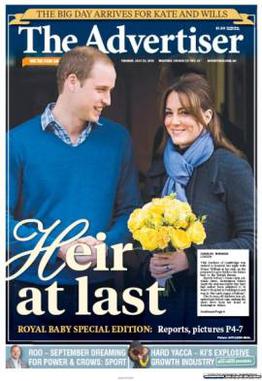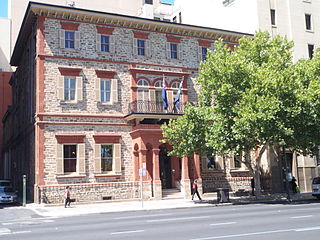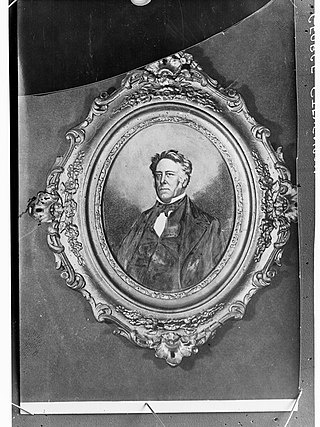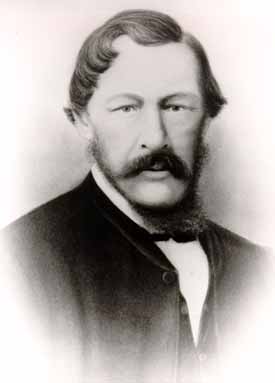
The Advertiser is a daily tabloid format newspaper based in the city of Adelaide, South Australia. First published as a broadsheet named The South Australian Advertiser on 12 July 1858, it is currently a tabloid printed from Monday to Saturday. The Advertiser came under the ownership of Keith Murdoch in the 1950s, and the full ownership of Rupert Murdoch in 1987. It is a publication of Advertiser Newspapers Pty Ltd (ADV), a subsidiary of News Corp Australia, itself a subsidiary of News Corp. Through much of the 20th century, The Advertiser was Adelaide's morning broadsheet, The News the afternoon tabloid, with The Sunday Mail covering weekend sport, and Messenger Newspapers community news. The head office was relocated from a former premises in King William Street, to a new News Corp office complex, known as Keith Murdoch House at 31 Waymouth Street.

The Adelaide Club is an exclusive gentlemen's club situated on North Terrace in the South Australian capital city of Adelaide. Founded in 1863, the club comprises members of the Adelaide Establishment.

George Stevenson was a pioneer South Australian newspaper editor and horticulturist. He came to Adelaide as private secretary to the first Governor of South Australia, John Hindmarsh.

Robert Thomas was a Welsh newspaper proprietor, printer and early settler of South Australia who was born on a farm 'Rhantregynwen', at Llanymynech, Powys, Wales.

Sir Robert Kyffin Thomas was a South Australian newspaper proprietor.

John Howard Clark was editor of The South Australian Register from 1870 to 1877 and was responsible for its Echoes from the Bush column and closely associated with its Geoffry Crabthorn persona.
The South Australian was a newspaper published in Adelaide, the capital of colonial South Australia from 2 June 1838 to 19 August 1851. Between 1838 and 1844, it was published as The Southern Australian.
John Stephens was a writer, polemicist and editor in England who became an editor and newspaper owner in the early days of South Australia.
The Herald was a weekly trade union magazine published in Adelaide, South Australia between 1894 and March 1910; for the first four years titled The Weekly Herald. It was succeeded by The Daily Herald, which ran from 7 March 1910 to 16 June 1924.
William Kyffin Thomas was a newspaper proprietor in South Australia. William, the son of Robert Thomas, was born in Fleet Street, London and emigrated to South Australia with his father in 1836 on the Africaine. From that time until the day of his death, he was intimately associated with the fortunes of the South Australian Register, for the last twenty-five years of his life as one of the proprietors. To his industry and ability in the different capacities in which he acted was due to a large extent the high character and phenomenal success of the Register, and the weekly and afternoon journals issued from the same office—the Adelaide Observer and Evening Journal. The firm which conducted these papers bore the name of the subject, being known as W. K. Thomas & Co., and consisted of John Harvey Finlayson and Robert Kyffin Thomas, the latter being the elder son of William Kyffin Thomas, and grandson of the founder of the Register.

The Southern Cross is the official publication of the Catholic Archdiocese of Adelaide. About 5000 copies are printed monthly and distributed to parishes, schools and agencies, besides an online version. It began in July 1889 as a weekly magazine published in Adelaide, South Australia, for the Catholic Archdiocese of Adelaide, and remained a weekly for most of its history. Its banner was subtitled A weekly record of Catholic, Irish and General Intelligence, and later Organ of the Catholic Church in South Australia. The current, non-print website version of the magazine also bears the name Southern Cross.

Andrew Murray (1813–1880) was an Australian journalist.
Quiz was a weekly newspaper published in Adelaide, South Australia from 1889 to 1910. Between 1890 and 1900 it was known as Quiz and The Lantern.
Charles Birks & Co Ltd. was a South Australian department store founded by Charles Napier Birks in Rundle Street, Adelaide. His son Napier Birks took over the business in 1908. The business was acquired by David Jones Limited in 1954.
The Port Adelaide News was a newspaper published in Port Adelaide, South Australia between 1876 and 1933 with various sub-titles, several breaks in publication and periods of bi-weekly publication.
The Kapunda Herald was a newspaper published in Kapunda, South Australia from 29 October 1864 to 25 January 1951. From 1864 to 1878 the masthead was subtitled "and Northern Intelligencer". It was published weekly, except for the period February 1872 to September 1894 when it appeared bi-weekly. When closed, the newspaper was merged with the Barossa News to become the Barossa and Light Herald.
The Adelaide Chronicle was an early publication in Adelaide, the capital of the then colony of South Australia. It was published between 1839 and 1842, when it ceased publication as a result of the economic depression caused by the mass exodus of workers to the Victorian goldfields.
The Adelaide Times was an early newspaper founded by James Allen and printed in Adelaide, the capital of the then colony of South Australia. It was published between 2 October 1848 and 8 May 1858, and evolved through a series of names and publication frequencies, and closed due to uncertainty surrounding Allen's bankruptcy.
Henry Hussey was a pastor in the colonial days of South Australia, closely associated with the Christian Church on Bentham Street along with pastors Abbott, Finlayson and Playford. He was the author of several influential books on religious themes, and a memoir.
Nathaniel Hailes was an English journalist who had a considerable career in South Australia as a land agent and in administration. He contributed to various newspapers under the byline "Rifleman" and as "Timothy Short".








